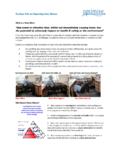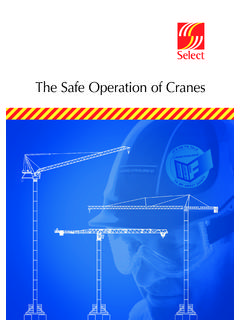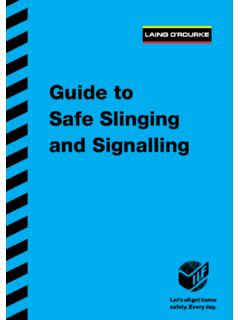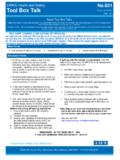Transcription of Tool Box Talk Issue: ANIMAL/LIVESTOCK HAZARDS – May …
1 tool Box Talk issue : Author: ATL Thames Valley Meter Reading Approver: SHEQ Manager Approval Date: 21/05/2013 A N I M A L / l i v e s t o c k H A Z A R D S ANIMAL/LIVESTOCK HAZARDS May 2013 Introduction There has been a recent case in the local media, citing an incident involving cattle/ livestock pursuing and in this case attacking people within a rural enclosure/field. Thankfully, incidents such as these are relatively rare and would usually have involved the presence of dogs, which the livestock perceive as a threat. The purpose of this bulletin is to remind workers of the requirement to complete a point of work risk assessment before they enter an area where they are likely to encounter animals/ livestock in order to ensure their safety whilst carrying out the task.
2 These are general guidelines for this type of hazard and more local conditions may also be pertinent. This TBT should be read in conjunction with the Vennsys Risk Assessment MRRA006 Animal HAZARDS , a copy of which is to be held within your folder. Performing the risk assessment The farmer/end customer should, if possible, be contacted to minimise the risks. The point of work RA should be conducted BEFORE entering the field/enclosure. Questions to ask yourself include; What are the HAZARDS associated with this task? o What livestock is present? Cattle, Horses, Swine, Sheep, Deer, Geese, etc. o Look for livestock indicators, cow pats, etc. Does it look old or fresh? o Can you see all of the enclosure?
3 Look for areas that may be out of sight. o If livestock is present, are there mothers with their young? o Are there dominant males (bulls, etc.)? How many are there? o Can you see a safe passage to and from the pit? Who may be harmed? o Are you on your own, or working as part of a team? o What is your physical condition? Are you able to get over that fence if necessary? What can you do to lower the risk of you or your team being harmed? o Have you spoken to the farmer/customer and asked for their assistance in approaching the pit and avoiding the animals? o If you are on your own, have you activated LoneALERT on a shortened time period? tool Box Talk issue : Author: ATL Thames Valley Meter Reading Approver: SHEQ Manager Approval Date: 21/05/2013 A N I M A L / l i v e s t o c k H A Z A R D S o Can you get to the pit by following the hedge line and in doing so being less conspicuous to the animals?
4 O Look for the closest escape route from where the pit is - you may need to use it. Take into consideration that the escape route may be over a barbed wire fence or similar. It may be through a gate or stile. Either way make sure that it can be opened quickly if required. o If you are in any doubt, do not enter the enclosure/field but contact you line manager, inform them of the situation and ask for their advice. Record your actions o Make sure you record any other useful or significant details in your notes as required. Continue to review your risk assessment while you are working, and be prepared to stop and re-assess if the circumstances change. If it was safe last time you visited the site, don t automatically assume it will safe every time.
5 Conversely, if it was unsafe last time, don t assume it will always be unsafe. livestock does get moved throughout the seasons. Zero Incidents Zero Harm Zero Compromise









